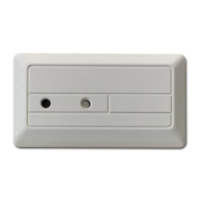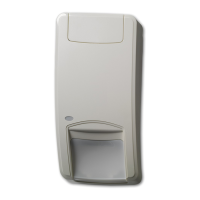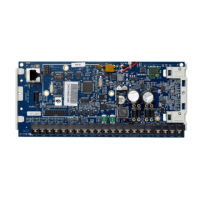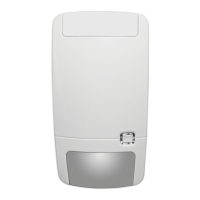2 / 14 P/N 422-6367-ML • REV E • ISS 03DEC18
10
EN: Installation Sheet
Description
GS960 is an acoustic glass break detector giving an alarm
when glass is smashed at intruder attempts through windows,
doors and glazed walls.
The detector is based on advanced microcontroller technology
and programmed to take a lot of relevant acoustic factors into
account: the Digital Room Compensation (DRC). This makes
the detector able to distinguish between a true glass break and
other irrelevant sounds.
The detector is for indoor use. The coverage distance is 1 to
9 m (see Figure 2). The coverage angle is 165°, which means
that one detector can protect several windows in the same
room. The detector can be mounted in the ceiling or on a wall
with a free “line-of-sight” to the window being protected.
GS960 is certified according to EN 50131-2-7-1:2012, Security
Grade 2.
Figure 1: Detector layout
(1) Cover lock
(2) Base
(3) LED
Figure 4: Detector base after removal of the cover
(1) Cable jacket “knock-out”
(2) Terminal block
(3) Mounting hole 1
(4) Cover screw
(5) Mounting hole 2
(6) Mounting hole 3
(7) Slots for assembling the cover
hooks
Figure 5: Cover seen from below
(1) Cover lock
(2) Terminal block pins
(3) Tamper switch
(4) PC interface
(5) DIP switch
(6) Hooks holding the cover to the
base
Connection to a 24-hour loop
The detector is constructed for continuous supervision and is
extra resistant to different acoustic disturbances. It will function
well in most environments. However in rooms with very high
rates of disturbances as in industrial workshops and gyms, it is
recommended to test the detector for 3 to 4 weeks before
deciding to use it continuously. In rare cases a combination of
random sounds can trigger an alarm.
Signalled events
Detector has a relay and one micro-switch to signal detected
and processed events to control panel in prioritised order as
following signals:
• Glass break – signalled by INTRUSION relay
• Sabotage – signalled independently by TAMPER micro-
switch.
Signal sent by relay or micro-switch
Special tools
In most rooms (for example, offices) no special tools are
required during the installation. In rooms with complicated
acoustics it is recommended to use the GS960-TR tester.
GS960-TR can also be used for function test and annual
service.
See also “Check the settings with GS960-TR tester” on page 4.
Opening the detector
See Figure 3.
To open the detector, follow these steps:
1. Slide the lock cover up (Figure 3, item 1)
2. Loosen the screw (item 2)
3. Pull cover to open (item 3)
Mounting instructions
• Detector should be installed on a ceiling or on a wall
opposite to the glass to be protected.
m
a
x
.
8
.
5
m
m
a
x
.
9
m
min. 0.5 m
min. 0.3 m
min.
1 m
min. 0.5 m

